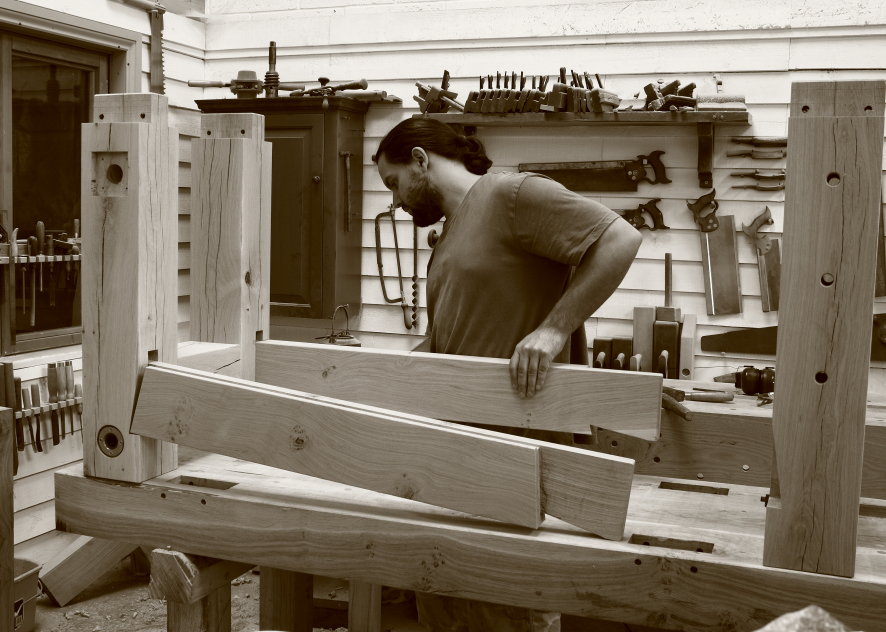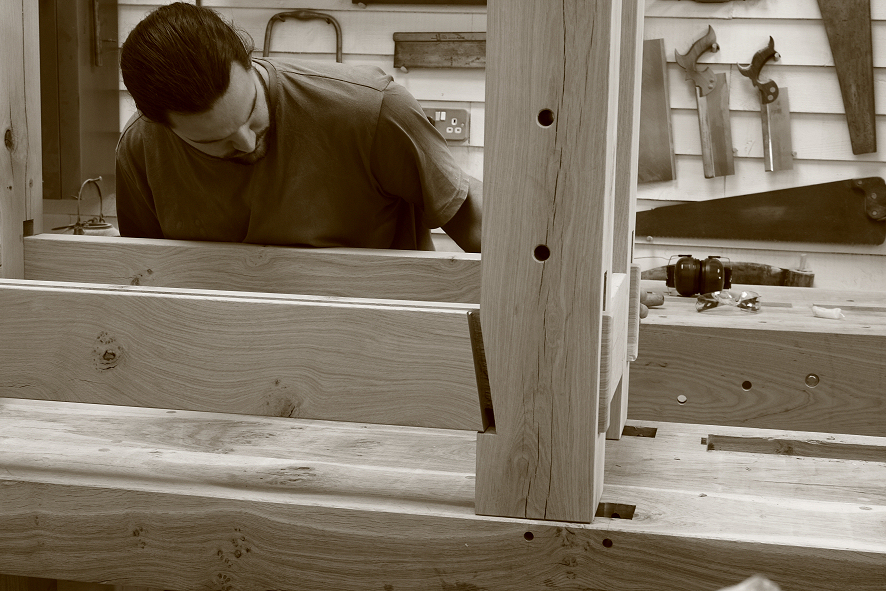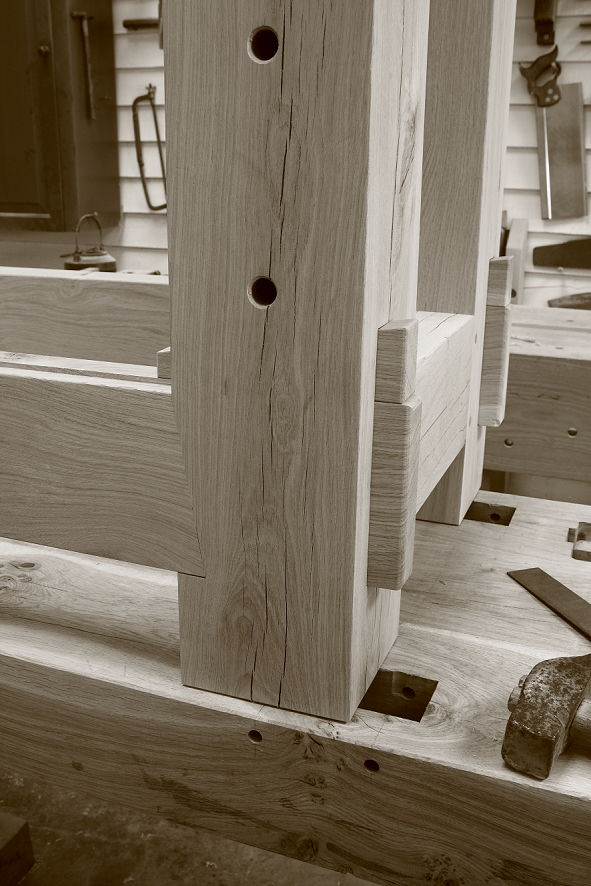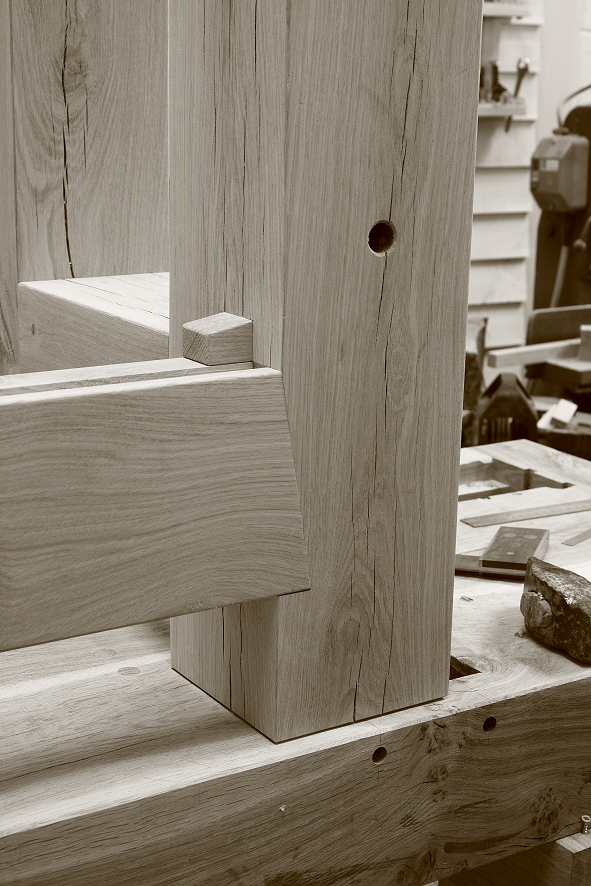 Needs Pictures: 0
Needs Pictures: 0
 Picture(s) thanks: 0
Picture(s) thanks: 0
Results 16 to 30 of 30
Thread: What is is joint called????
-
5th January 2015, 11:22 PM #16
-
5th January 2015 11:22 PM # ADSGoogle Adsense Advertisement
- Join Date
- Always
- Location
- Advertising world
- Posts
- Many
-
7th January 2015, 10:22 AM #17

Dovetailed and wedged tenon here ... http://www.timberframe-tools.com/ref...-tenon-joints/
but I have seen a timber-framing joint which started with a mortice to bear the weight of the cross-beam, plus the dovetail/wedge bit to lock it in.
Cheers,
Paul
-
7th January 2015, 10:39 AM #18

I was possibly thinking of this one ... but I feel I have also seen the one I mentioned as well.
http://timberframehq.com/wedged-half...o-post-detail/

-
7th January 2015, 10:47 AM #19

Excellent article
 The person who never made a mistake never made anything
The person who never made a mistake never made anything
Cheers
Ray
-
7th January 2015, 11:05 AM #20

" fully housed, counter-wedged dovetail through tenon" and the reason for it ... http://www.chaplinoak.co.uk/archbrace/

-
7th January 2015, 11:38 AM #21

Not sure but it appears to me to be that the rail might actually be two boards laminated together, hence the apparent rebate along the top.
If this is the case then the board towards the centre of the bench has a "modified" version of a wedged through dovetail tenon, whereby the mortise has been cut in a dovetail shape instead of a parallelogram and the wedge has therefore been stuck in backwards. I see that in PMcgee's post above the wedge runs the correct way for this type of joint but it runs the opposite way in DSel's example.
If this is the case then the "dovetail" features on the ends of the outside lamination are just for positioning of the outer board, but cut in such a way as to allow the entire laminated rail to be removed once the wedge is knocked out.
I can see nothing to recommend it over a standard wedged through dovetail tenon.
Cheers
DougI got sick of sitting around doing nothing - so I took up meditation.
-
7th January 2015, 01:49 PM #22
 Senior Member
Senior Member











- Join Date
- Jun 2007
- Location
- Queanbeyan NSW
- Posts
- 231
-
7th January 2015, 10:07 PM #23

The way I see it the whole width of the crossmember becomes weight bearing and takes stress off the tenon. Not really required in that bench but would have applications in things like bridges, wharves or buildings.
Regards
John
-
7th January 2015, 11:15 PM #24

Well, unless your joinery is absolutely spot on, either the tenon will be taking all the weight or the half dovetail on the front part of the joint will.
Either way, driving in the wedge will transfer ALL the load onto the interface between the top of the wedge and the top of the mortise. Since this is identical in size and angle to the bottom of the mortise, I cannot see how the extra material and the part-dovetails on the end are helping at all. In fact, the way the joint is constructed with the wedge in backwards, it looks to me that the racking forces when planing on this bench will have the affect of loosening the wedges. If the half-dovetails on the rail are at the same angle as the wedge that makes a 90 degree angle but if the wedges were inserted the other way it would produce an acute angle which would mean that the wedge was pulling the joint together against the racking force whereas a 90 degree angle has a neutral effect.
The racking forces that the bench is supposed to be designed to withstand would be controlled much better by redesigning the joint to insert the wedge from the opposite side. If this was done then there might also be something to gain by the outer piece with the dovetail angle on the outside. Without this, I cannot see any purpose other than aesthetic for the outer part of the rail.
Cheers
DougI got sick of sitting around doing nothing - so I took up meditation.
-
8th January 2015, 10:12 PM #25

Great bit of detective work, Mr McGee. But aren't you taking an eachway bet?
In your first post above your source describes it as ".... a half dovetail tie beam tenon ...." whilst this source says it is a "..... fully housed, counter-wedged dovetail through tenon .....".
I wondered why the latter was counter wedged, but the explanantion is obvious - the wedges in DSEL's original quest has the wedges driven in the opposite direction!
Personally, I thought the joints were almost diabolical enough to be Japanese!
Fair Winds
Graeme
-
8th January 2015, 10:29 PM #26

It seems the joint has origins it roofing by your research.
I have since seen it used exactly the same way as my original post on two more benches. I suspect the use on a bench may originate with a bench build DVD from finewoodworking. Although I don't have a subscription /membership to view it. Suppossed to be free plans but I can't see them either. Intro is interesting.
http://www.finewoodworking.com/item/...oubo-workbench
http://www.tauntonstore.com/hybrid-r...ch-065124.html…..Live a Quiet Life & Work with your Hands
-
9th January 2015, 08:18 AM #27

The pictures on pmcgee's posts make more sense about the origins and purpose of this joint, which seems to be green oak roof trusses as are found in old English buildings. The lip helps support what must be massive loads the wedge on the tenon prevents the beam moving away from the post the top wedge ensures that the bottom part of the lock is fully engaged and tightens with further movement. Presumably the wedge needs to be on that side to allowmaintenance. The other side may not be accessible due to the prescence of cladding, etc. I wonder why the joint is depicted as needing pegs in some of the drawings?
I also have to say "I told you so". I said that that size of timber and the joints in the original post belong in bridges etc, and ther prescence in a work bench represent a massive bit of over engineering, which reminds me:
When asked what 2+1 equals, an Engineer will answer "It's 3, but let's call it 9 to be on the safe side".
Interesting discussion fellas.
-
9th January 2015, 09:19 AM #28

Anyone can design a bridge that can do the job, but it takes an engineer to design a bridge that can "just" do the job.
When my brother was doing his engineering degree he had a t-shirt with "How can you tell an engineer?" written on the front.
On the back it said "You can't, he already knows."
Cheers
DougI got sick of sitting around doing nothing - so I took up meditation.
-
9th January 2015, 10:48 AM #29

I had looked at these before ... including being influenced by that FWW video some time ago ... because I have an ambition towards a refectory table and have thought about it in that context.

Cheers,
Paul
-
9th January 2015, 11:02 AM #30

Off topic I know, but please indulge me... I studied Industrial Chemistry (i.e. I'm a scientist) at the school of Chemical Engineering and Industrial Chemistry at UNSW. When asked about the difference between the two the head of the school (an Engineer) said:
"Engineers are taught to do what they have always done, scientists are taught to be creative"
He was not trying to deride Engineers, on the contrary. When asked about building a road, the Engineer will tell you how to prepare the surface how much road base, bitumen and so on to use to get it just right (and they are creative in that way) ... A scientist will ask you " Are you sure that a road is the best solution? Maybe we should have a rail line or something" and then provide you with a detailed analysis of all the possible options.
In the end you need both types of thinkers (and maybe a few other types) to do a really good job in any situation.
Similar Threads
-
Is it called a "keyhole joint"?
By Rookie in forum WOODWORK - GENERALReplies: 9Last Post: 25th May 2023, 08:39 PM -
Mitre joint with biscuit joint
By hsc07ww in forum WOODWORK - GENERALReplies: 4Last Post: 30th November 2006, 10:10 AM



 Thanks:
Thanks:  Likes:
Likes: 

 Reply With Quote
Reply With Quote




